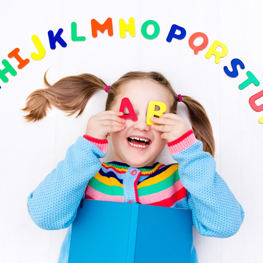
Helping kids learn spelling words can be b-o-r-i-n-g for everyone. Some parents coach kids to read the words over and over. Others ask kids to write the words out 10 times each. These strategies may make the grade if your child is a quick study, but they don’t help them notice patterns or make connections with other knowledge. And that kind of deeper learning turns spelling sessions into higher-level brain training. Studies show multi-sensory techniques that use sight, hearing, touch, and movement simultaneously lead to more efficient and effective learning.
Try these smart strategies to amp up learning and make spelling fun for your kids:
Make word puzzles. Write words on index cards and cut them up into segments. Kids can practice spelling by putting words back together. Breaking words up into syllables reminds kids how to sound out words and emphasizes components they can use to decode the word’s meaning.
Play scrabble. Get out this board game and ask your child to create a scrabble setup using only the words from the spelling list. Making the words is an active, tactile, and visual learning process that keeps kids engaged. Add math practice by calculating which word scores the most points.
Categorize. Make a chart with columns for each kind of word in the spelling list, and let learners put each one in its place. You might have columns for words with “er” or “ir” or for “objects,” “actions,” and “adjectives.” Our brains like to store information in categories, so this task helps kids remember words better.
Alphabetize. Instead of writing the list in the same order repeatedly, reorganize it each time. First, copy the list as provided. Then, write words in alphabetical order. On the next round, write them in order from shortest to longest. Capturing information in several ways forces kids to really think about each word instead of copying mindlessly.
Make up mnemonics. Some words are so hard to spell that the only way to remember them is to make up a memory aid. You’re probably familiar with rhymes such as “‘i’ before ‘e,’ except after ‘c,’” or “sounding like ‘a’ in ‘neighbor’ and ‘weigh.’” Encourage kids to make up their own silly sayings or simple songs to remember tricky spellings. The best memory aids are the ones kids create for themselves.
Feel it out. Fill a cookie sheet with sand and have your child write out words with their fingertip. Or - for some good clean fun - let them finger paint spelling words on the bathtub walls using shaving cream. Tactile sensations form an additional memory that trace learners can use during recall. Kids can retrace movements on their desktop during the spelling test.
Highlight the hard parts. Prompt kids to write words with colored markers and bold strokes, putting additional emphasis on troublesome letters or syllables. For instance, your child might write mOnkey to remind themself that the first vowel in this word is “o,” not “u.” Vivid visual features stand out in our memories. Adding ears and a mouth to turn the “O” into a monkey face would make this even more effective.
Talk it up. Challenge your child to read their word list and emphasize difficult aspects by mispronouncing them. The word “separate” sounds like sep-AY-rate when you exaggerate the middle syllable, which is often misspelled. Verbalizations provide auditory cues kids can use to recall correct spellings.
Write five phrases. Use each word to create five alternate phrases. Writing “block of ice” and “around the block” connects the word block to other things your child already knows. Putting words into context also gets kids to think about the sound and meaning of the words, rather than copying letters.
Make up a story. See how many words from the list can be combined into a single sentence or paragraph. Writing “The wood duck stood on a stool to prove he could shoot the fool” is a lot more challenging than listing words in isolation. Creative tasks make practice more engaging and more memorable.
Draw a doodle. Let little artists create custom doodles that bring words to life on the page. Turn individual letters into symbols - like a snake in place of the “s” or a boomerang in place of a “v” - or draw the word’s meaning in the spaces around the letters.
Get physical. Have a spelling practice dance party and act out words using your entire body, like a cheerleader might spell out v-i-c-t-o-r-y. Muscle movements form their own memory traces in this ultimate active-learning strategy.
Heidi Smith Luedtke, Ph.D., is a personality psychologist, former educator, and mom of two. She is the author of Detachment Parenting.
Calgary’s Child Magazine © 2024 Calgary’s Child